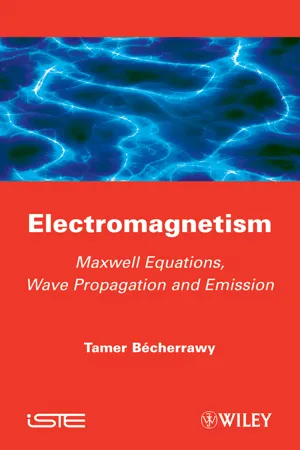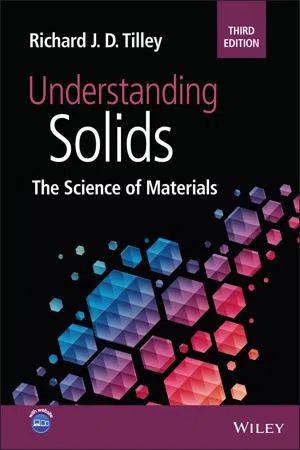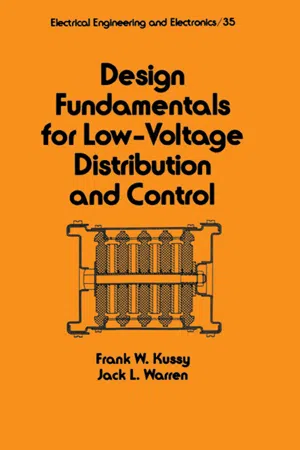Physics
Ohmic Conductor
An ohmic conductor is a material that obeys Ohm's law, which states that the current passing through the conductor is directly proportional to the voltage applied across it. In an ohmic conductor, the resistance remains constant regardless of the applied voltage. This behavior allows for a predictable and linear relationship between current and voltage.
Written by Perlego with AI-assistance
Related key terms
Related key terms
1 of 4
Related key terms
1 of 3
6 Key excerpts on "Ohmic Conductor"
- eBook - ePub
Electromagnetism
Maxwell Equations, Wave Propagation and Emission
- Tamer Becherrawy(Author)
- 2013(Publication Date)
- Wiley-ISTE(Publisher)
semiconductors (silicon, germanium, tellurium, etc.). Their resistivity depends strongly on the impurities they contain (small amounts of foreign atoms that are introduced into the semiconductor).3.8. Resistance of conductors
Experimental studies starting with Ohm in 1826 showed that each segment of a conductor has a characteristic quantity, known as the resistance R, such that the drop in the potential between its ends is related to the current by Ohm's law[3.49]The SI unit of R is the volt/ampere, called ohm (Ω). R depends on the material and the geometrical form of the conductor, on the impurities that it contains, and its temperature. Ohm's law applies to a variety of conductors said to be Ohmic. A plot of V versus I (called characteristic) for an Ohmic Conductor is a straight line passing through the origin with a slope R (Figure 3.11a ). In other words, for such materials, R (defined as V/I) is independent of I (or V) and, if the potential difference is reversed, the current through the conductor is reversed without change of intensity. Metals are almost Ohmic, but there are many conductors that are not (see Figure 3.11b and 3.11c ). An ionized gas, a diode, etc., are non-Ohmic. Connection wires of reasonable length have usually a very small resistance and a conductor that serves to introduce a resistance in the circuit is called resistor. The dissipated power in the conductor of resistance R is[3.50]To see how the resistance depends on the shape of a conductor, let us consider a cylindrical wire of uniform cross section S and length L with the potential V applied between its ends. The conservation of electric charge implies that the current intensity is the same at any point of the wire and, if the section is uniform and the current density is uniform over the cross section, the current density j = I/S is the same everywhere in the conductor. On the other hand, the translational symmetry implies that the electric field E has the same magnitude along the wire; thus, using the local form of Ohm's law E = ρj, we find V = EL = ρjL = (ρL/S)I. This corresponds to a resistance R = ρL/S - eBook - ePub
OAT Prep Plus 2023-2024
2 Practice Tests + Proven Strategies + Online
- (Author)
- 2023(Publication Date)
- Kaplan Test Prep(Publisher)
ρ. Thus, good conductors have low resistivities, whereas poor conductors are good insulators and have high resistivity values.Temperature
Most conductors have greater resistance at higher temperatures. This is due to increased thermal oscillations of atoms in the conductor, which produce a greater resistance to electron flow. The resistivity is therefore a function of temperature. However, a few materials, such as glass, pure silicon, and most semiconductors are exceptions to this general rule.Power dissipated by a resistor
Electric potential is defined in Chapter 68 as electric potential energy per unit of positive charge. Since current is a flow of charge, a current-carrying resistor also has a flow of energy. In a resistor, this electric energy is converted into heat, light, or electrical work. Since power is defined as change in energy over change in time, the rate at which the energy conversion occurs is equal to the power dissipated by the resistor and is given by:where I is the current flowing through the resistor and V is the drop in electric potential across the resistor. Using Ohm’s law this expression can be rewritten as:Circuit Laws
An electric circuit is a conducting path that usually has one or more voltage sources (such as a cell) connected to one or more passive circuit elements (such as resistors). A discussion of DC circuits deals primarily with voltages, resistances, and currents. Kirchhoff’s laws provide an understanding of how these three factors are related to DC circuits.Kirchhoff’s laws
Kirchhoff’s current (1st) law states that at any junction in a circuit the sum of currents directed into that point equals the sum of currents directed away from that point. This is a consequence of the conservation of electric charge.Example: Three wires (a, b, and c) meet at a junction point P as in Figure 70.1 - eBook - ePub
Materials
Engineering, Science, Processing and Design
- Michael F. Ashby, Hugh Shercliff, David Cebon(Authors)
- 2009(Publication Date)
- Butterworth-Heinemann(Publisher)
Figure 14.1 The hierarchy of electrical behaviour. The interesting ones are boxed in red, with examples of materials and applications. Their nature and origins are described in this chapter.14.2 Conductors, insulators and dielectrics
Resistivity and conductivity
The electrical resistance R (units: ohms1 , symbol Ω) of a rod of material is the potential drop V (volts2 ) across it, divided by the current i (amps3 ) passing through it, as in Figure 14.2 . This relationship is Ohm’s law:Figure 14.2 Electrical resistivity, ρ e . Its value ranges from 1 to 1024 µ Ω.cm.(14.1)The material property that determines resistance is the electrical resistivity , ρ e . It is related to the resistance by(14.2)where A is the section and L the length of a test rod of material—think of it as the resistance of a unit cube of the material. Its units in the metric system are Ω.m, but it is commonly reported in units of µ Ω.cm. It has an immense range, from a little more than 10−8 in units of Ω.m for good conductors (equivalent to 1 µ Ω.cm, which is why these units are still used) to more than 1016 Ω.m (1024 µ Ω.cm) for the best insulators. The electrical conductivityκeis simply the reciprocal of the resistivity. Its units are siemens per meter S/m or (Ω.m)−1 .Dielectric properties
First, a reminder of what is meant by a field: it is a region of space in which objects experience forces if they have the right properties. Charge creates an electric field , E . The electric field strength between two oppositely charged plates separated by a distance t and with a potential difference V between them is(14.3)and is independent of position except near the edge of the plates.Two conducting plates separated by a dielectric make a capacitor (Figure 14.3 ). Capacitors (sometimes called condensers) store charge. The charge Q (coulombs4 ) is directly proportional to the potential difference between the plates, V (volts):Figure 14.3 - eBook - ePub
Understanding Solids
The Science of Materials
- Richard J. D. Tilley(Author)
- 2021(Publication Date)
- Wiley(Publisher)
11 Electronic Conductivity in Solids- What is n‐type and p‐type silicon?
- How are conducting polymers produced?
- What is a cuprate superconductor?
Solids that allow an electric current to flow when a small voltage is applied are called conductors or semiconductors. Conductivity requires the presence of mobile charge carriers. In this chapter, solids that have reasonable numbers of mobile charge carriers present, either because of their native electronic properties, or because they have been deliberately introduced by doping, are considered. In addition, superconductors, a group of materials that appear not to use ‘normal’ conductivity mechanisms, are described.11.1 Metals
11.1.1 Metals, Semiconductors, and Insulators
One of the defining physical properties of a metal is its electrical conductivity, defined via Ohm's Law,where V is the voltage applied across the material, I is the resultant current, and R is the resistance. The resistance is proportional to the length of the material, L, and the cross‐sectional area, A:whereρis the resistivity. The resistivity of a solid is an intrinsic property, whereas resistance depends upon the dimensions of the sample. The conductivity of a solid is the inverse of the resistivity:Electrical conductivity in a metal is due to electrons that are free to move, i.e. gain energy, under the influence of an applied voltage. Metallic bonding allows conductivity to be understood most easily. In this model, the electrons on the atoms making up the solid are allocated to energy bands that run throughout the whole of the solid. A simple one‐dimensional band‐structure diagram, called a flat band diagram, allows the broad distinction between conductors, semiconductors, and insulators to be understood.If the number of electrons available fills an energy band completely and the energy gap between the top of the filled band and the bottom of the next higher (empty) energy band is large, the material is an insulator (Figure 11.1 a). This is because the electrons have no means of taking up the additional energy needed to allow them to move under a low voltage, because all of the energy levels are filled or inaccessible. Only a considerable voltage will cause electrons to jump from the completely filled band to the next highest empty band, and when such a transfer does occur, the insulator has broken down - eBook - ePub
Electromagnetic Fields
Theory and Applications
- Ahmad Shahid Khan, Saurabh Kumar Mukerji(Authors)
- 2020(Publication Date)
- CRC Press(Publisher)
. It bears an inverse relation to the electrical resistance of a conductor. The resistance of a conductor is a function of material property and its size. For a given material, conductors with a larger cross-sectional area have less resistance than conductors with a smaller cross-sectional area. Low resistance conductors can carry more current.8.3.2.5 Isotropic and Anisotropic Conductors
If an electric field is applied to a material, and the resulting electric current is in the same direction, the material is said to be an isotropic electrical conductor . If this current is in a different direction from the electric field, the material is said to be an anisotropic conductor . For such materials the conductivity is not a scalar quantity.8.3.3 Continuity Equation
In electromagnetics the continuity equation is an empirical law expressing (local) charge conservation. Mathematically, it is a consequence of Maxwell’s equations, although charge conservation is more fundamental than these equations. The continuity equation can be expressed in both integral and differential forms.As described earlier the flow of electric charge in a conductor constitutes conduction current, or simply a current. Imagine that there is a closed surface bounding a volume v , and a current I is emerging out of this closed surface. This outward flow of current (or charges) implies that the total electric charge Q , stored inside this closed surface will decrease with time. This decrease will be justified only if there is neither creation nor destruction of electric charge inside the closed surface. In mathematical term,I = −d Qd t(8.21) 8.3.3.1 Integral Form
In Equations 8.2 and 5.38b, Equation 8.21 can be written as:· d s = −∯ sJdd t⋅ d v∭ vρ(8.22) Equation 8.22 is the integral form of the continuity equation . In this equation J is the current density and ρ is the charge density in the volume v bounded by the closed surface s - Frank Kussy(Author)
- 2017(Publication Date)
- CRC Press(Publisher)
1Impedance of ConductorsThe impedance of electrical conductors has a significant effect on the design of most electrical equipment. The conductors in such apparatus include bus bars, cables, terminals, contacts, pigtails, resistant wires, and coils. Often, the overall size, cost, and feasibility of the entire apparatus is determined by the size of these conductors. In turn, physical size is usually determined by the permissible temperature rise or heat capacity, mechanical function, and electrical impedance requirements.In this chapter we discuss the two components of conductor impedance, resistance and reactance. Temperature considerations are addressed in Chapters 2 and 3 .1.1 RESISTANCE OF CONDUCTORS
The calculation of electrical resistance is straightforward in direct-current (dc) circuits. The resistance R, in ohms, is given byR =ℓ ρA ( 1.1 )Table 1.1 Resistivity of Common Metalswhere ρ is the material resistivity in Ω-mm2 /m or 104 Ω-cm, and ℓ and A are the length and area of the conductor in meters and square millimeters, respectively. Values of resistivity for most metals (and their common alloys) can be found in material handbooks, material data sheets, or in manufacturers’ specifications. Table 1.1 lists the resistivity ρ of the more common conductor materials. Also included are the temperature coefficients, given as the percent change in resistivity per degree Celsius.In alternating-current (ac) circuits, resistance calculations can be complex. Unfortunately, there are many instances where these complex phenomena must be considered, due to their effect on design criteria. Three of these important phenomena are the skin effect, the proximity effect, and the housing effect.Figure 1.1 Skin effect.1.1.1 Skin Effect
Alternating currents induce an electromotive force (EMF) in the conductor which opposes the EMF associated with current flow. This induced EMF is greatest in the middle of the conductor, where the field strength is maximal. Although the total voltage drop over the cross section of a conductor is uniform, the ohmic and inductive components may vary due to the induced EMF. Specifically, the ohmic drop is greatest on the outer surface of the conductor and the inductive drop is greatest at the center. The resultant current flow is unevenly distributed over the cross-sectional area, reaching higher values on the outer surface. The net effect is an increase in the apparent ac resistance. This increased resistance may significantly affect the requirements of the conductor for heat dissipation. This phenomenon is called the “skin effect” because the current flow is increased at the outer skin or surface of the conductor (2).
Index pages curate the most relevant extracts from our library of academic textbooks. They’ve been created using an in-house natural language model (NLM), each adding context and meaning to key research topics.
Explore more topic indexes
Explore more topic indexes
1 of 6
Explore more topic indexes
1 of 4





